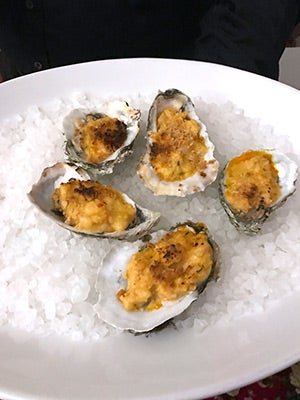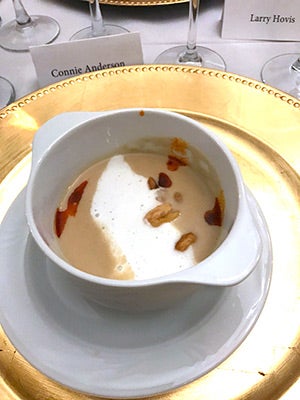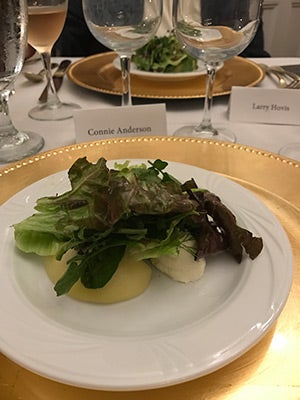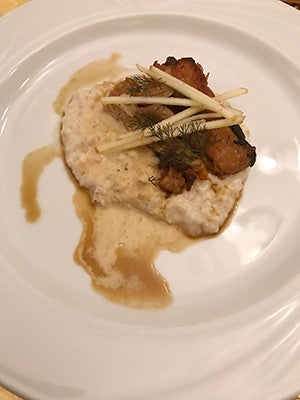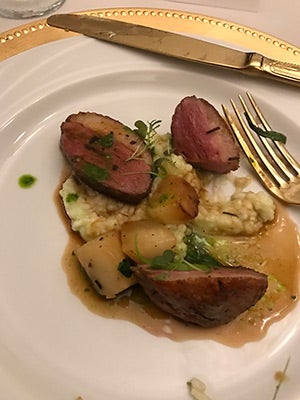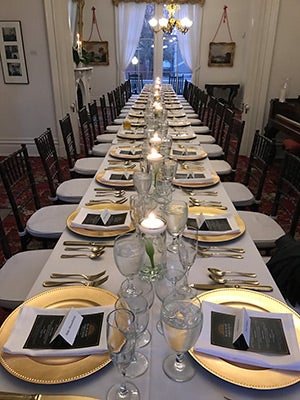Delicious, historic dishes served at mansion [with gallery]
Published 1:25 am Saturday, March 11, 2017
The Bellamy Mansion in Wilmington, N.C., hosted an ‘Antiquity Dinner’ the end of February. Now this was a fundraiser, and I usually do not do fundraisers, but this one sounded interesting. The event featured a five-course dinner themed on local ingredients and historic recipes from the museum archives.
The Bellamy Mansion was built in 1859 by Dr. John Dillard Bellamy, a physician with extensive landholdings and slaves and also a director of the bank and the railroad. The house has been a Wilmington landmark ever since. It is a two-story frame building set on a raised basement and topped by a cupula and surrounded by a porch on three sides with colossal Corinthian columns. It flaunts itself on the northeast corner of Market Street and Fifth Avenue, where a large fountain sets at the intersection of these two major streets in downtown Wilmington. As the grandest house in Wilmington it became headquarters for the federal forces after Wilmington fell in 1865, the last remaining port of the Confederacy.
In the 1870s and 1880s the house was frequently visited by Tommy Wilson (the future President Woodrow Wilson who lived in the Presbyterian manse a few blocks away). Tommy Wilson was a good friend of John Bellamy, Jr., who later became a U.S. Congressman.
The family remained in residence until the mid-20th century and later the house was turned over to Preservation North Carolina which maintains it today as a museum.
The idea behind the Antiquity Dinner, according to Gareth Evans, the director, was to use archived recipes and period foodways to create a new take on historic foods. By definition the foods are local, sustainable and fresh because that is what would have gone into the majority of the historic recipes.
Events such as this give an insight into how a household like this operated. The enslaved people had to prepare food for 20 people repeatedly during any given day. It was very hard work, of course. The foods made then – cornbread, collards, Hoppin’ John, pinto beans, grits and all the rest of classic Southern recipes – often came from this period and remain with us still. Because the food at the Bellamy site was prepared by enslaved people for a wealthy, white family, Evans said the meals often varied in content and style of preparation. There were likely African influences and undoubtedly an abundance of local produce, fish, poultry and meats. There might also have been hard-to-find foods that came in via the port, which only a wealthy family could afford.
The chefs selected to prepare the dinner were Dean Neff and Lydia Clopton of Pin Point restaurant in Wilmington. Dean Neff is perhaps the most innovative chef in Wilmington at the moment and his restaurant is not to be missed. Lydia Clopton is the pastry chef and her dessert was wonderful.
Highlights of the menu were pre-dinner vintage cocktails and hors d’oeuvres; baked Masonboro (the local sound) oysters with shrimp and palm oil (This was delicious.); and seared yellowfin tuna with radish, citrus, and benne seeds.
First course: Peanut Soup with whipped coconut and harissa (Peanut soup had been used early in America but the adding of coconut and harissa is a modern take.).
Second Course: Local lettuces with poached pears, marinated fresh farm cheese, toasted pecans, and honey-apple-sumac vinaigrette (This was very good.).
Third course: Berkshire pork belly, Anson Mills 20th century stewed oats, apple, and toasted peanut milk (so you see the use of pork here with oats instead of perhaps grits). I found the taste of the oats a little strange and would have chosen grits over the oats.
Fourth course: Duck breast with seared turnips, salted fatback, green onion, and charred turnip top middlins risotto. Middlins or brokens are the 30 percent of rice that is broken during processing. They can be purchased from Anson Mills as rice grits. They say they now purposely break rice to keep up with the demand from chefs for the middlins.
Fifth course: Dessert was coconut cake with Pawpaw Syllabub (delicious).
All of these courses were served with a small glass of wine to match the course. Thirty people were served but it was an intimate and wonderful evening.
I did not get the recipes for this dinner but found some that would be very close to the food served. Since I liked the soup very much I am giving the recipe for it.
North African Peanut Soup
Serves 10
2 Tbsp. plus 1 tsp. peanut oil, divided
1 Tbsp. Madras Curry
2 medium onions, sliced (about 4 cups)
2 tsp. minced garlic
2 large sweet potatoes or yams (about 2 pounds), peeled and cut into chunks
2 cups chicken broth
1 can (28 oz.) low-sodium whole tomatoes, drained and quartered
1 pound ground turkey
Sea salt to taste
Black pepper to taste
¼-1/2 tsp. harissa or to taste
1 cup chunky peanut butter
1 cup coconut milk
Heat 2 Tbsp. of peanut oil in a pot. Over medium-high heat, add the curry and cook, stirring constantly, for 1 minute. Add onion and minced garlic, stirring occasionally, for 2 minutes.
Stir in sweet potatoes, chicken broth, and tomatoes. Bring to a boil, reduce heat, cover and simmer for 20-30 minutes.
Heat remaining teaspoon of peanut oil and add turkey and cook, stirring to break up clumps, until cooked through. Season with salt and pepper. Drain excess fat.
Add harissa, peanut butter and coconut milk. Stir, and simmer and additional 20 minutes.


